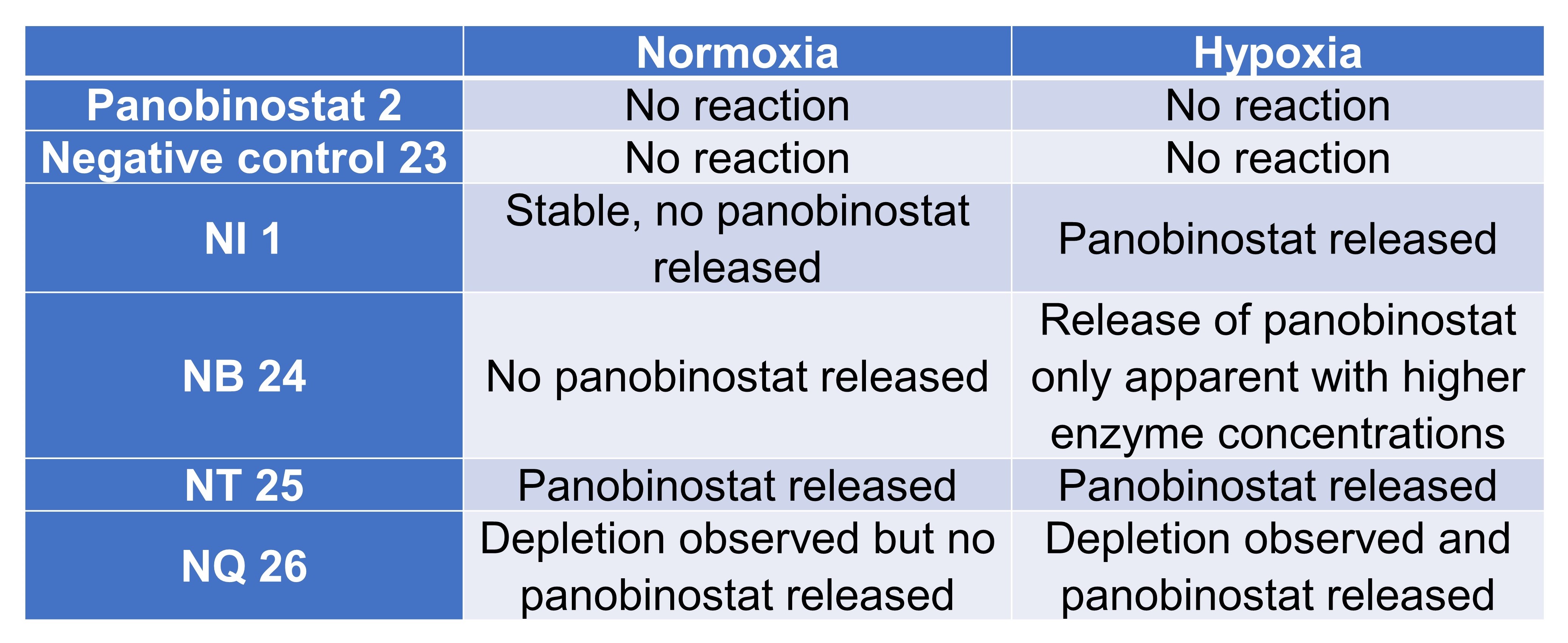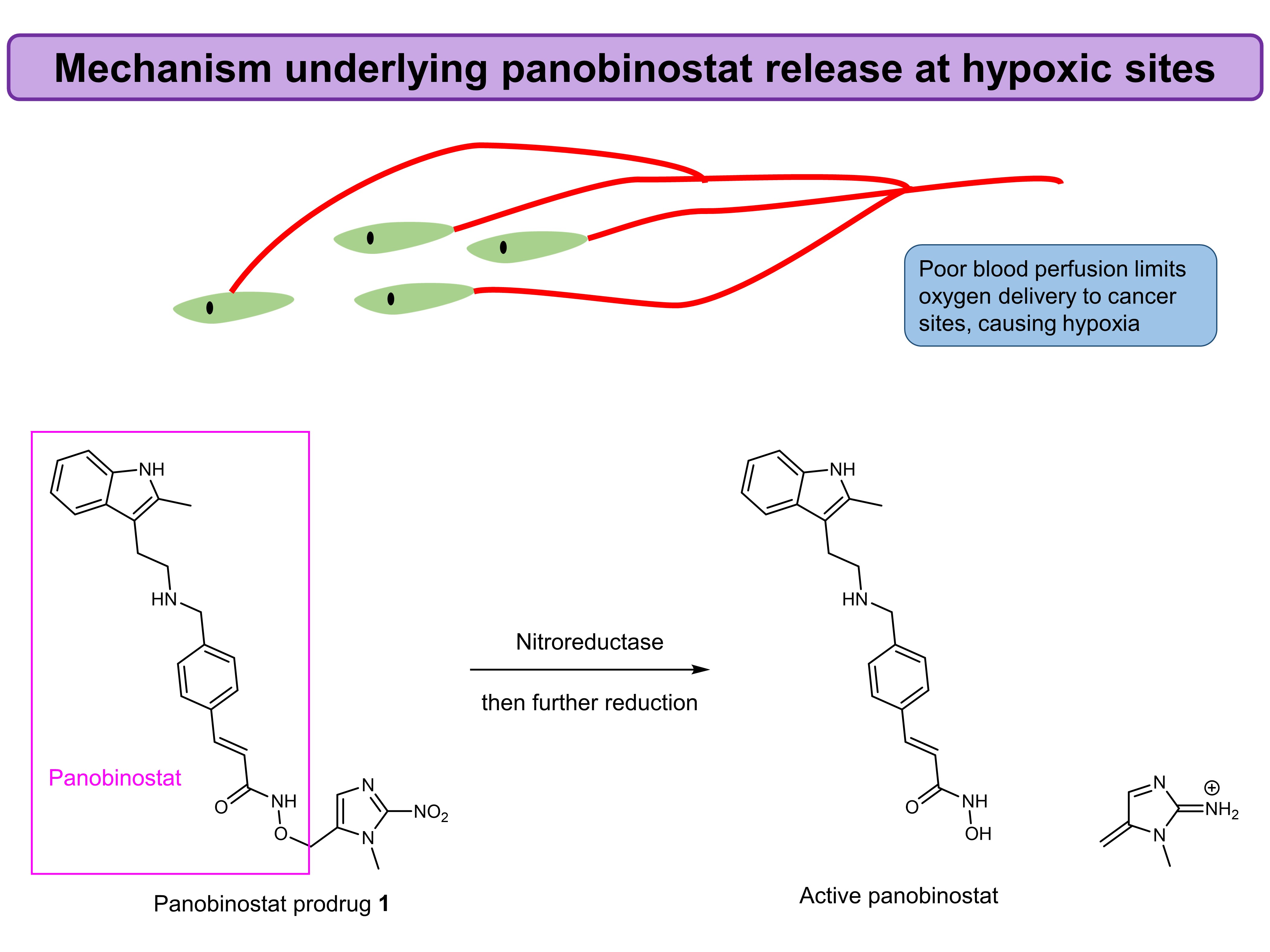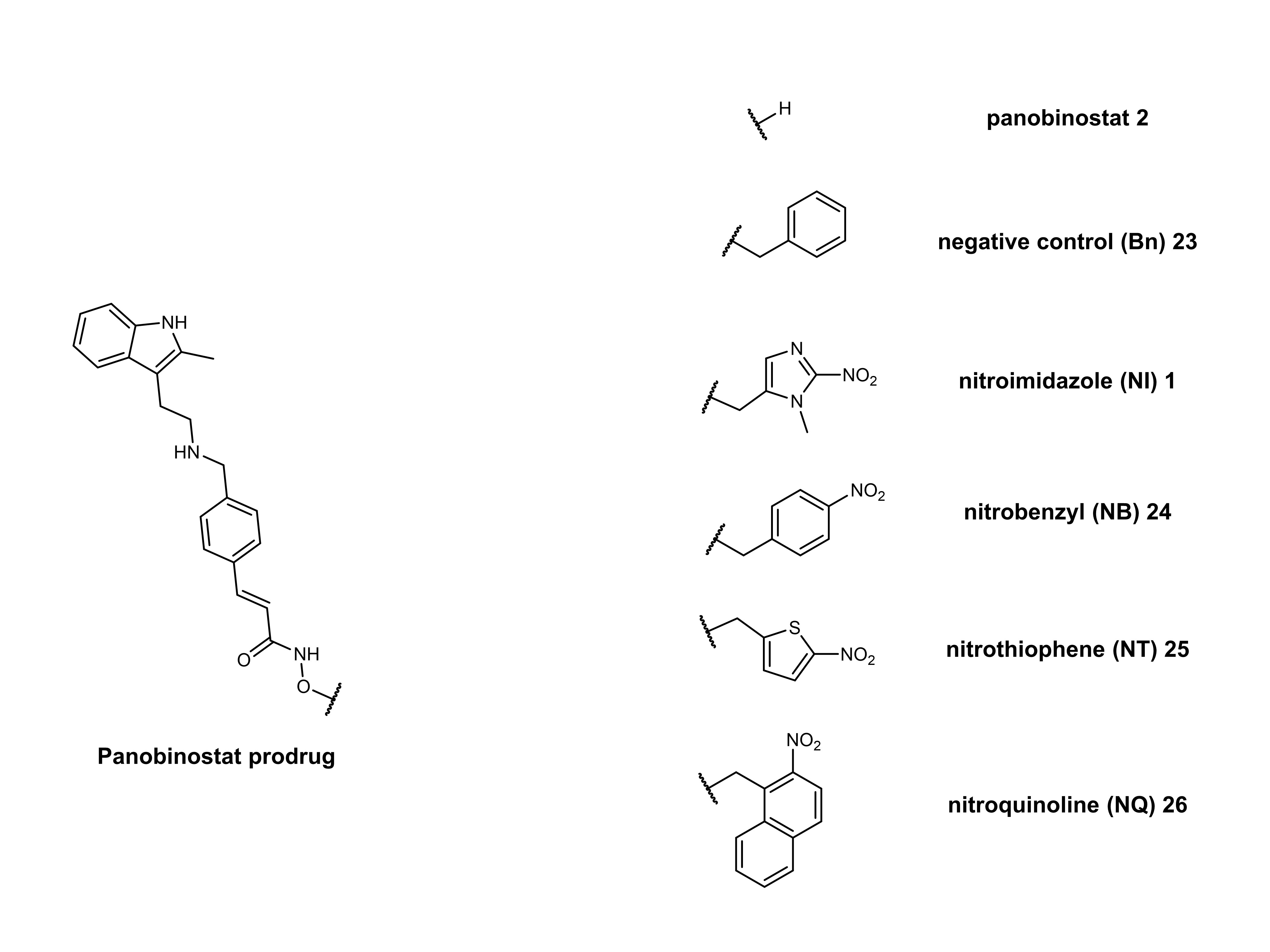The Design, Synthesis, and Evaluation of Hypoxia-Activated Prodrugs of the KDAC Inhibitor Panobinostat
Posted on: 1 February 2021
Preprint posted on 30 December 2020
‘Cause you carried me with you: prodrugs of the KDAC inhibitor panobinostat activated by low oxygen environments
Selected by Zhang-He GohCategories: microbiology, pharmacology and toxicology
Background of preprint: ‘cause you carried me with you
Prodrugs are substances that are converted by the body into their active drug forms. This can happen for a variety of reasons—ranging from poor solubility and absorption by the body to difficulties in reaching their intended physiological targets. In the case of anticancer therapy, it is especially difficult to deliver therapeutics to their intended site of action due to inefficient blood supply permeating tumours.
While this limited blood supply has traditionally proven a bottleneck in the anticancer drug delivery, researchers have turned this into a potential opportunity. For slightly over a decade, researchers have been developing prodrugs that can be activated by hypoxia—low oxygen levels—that is caused by the limited blood supply in tumours. These prodrugs, known as hypoxia-activated prodrugs, thus selectively target tumours with this characteristic.
In this preprint, Calder et al. have identified an opportunity to apply this concept to anticancer therapy involving histone / lysine deacetylases (H / KDAC), enzymes whose dysregulation have been implicated in oncogenesis. Notably, a few drugs that target KDAC have already been clinically approved, providing a good backdrop for this work. Indeed, the same group previously applied this strategy successfully to the KDAC inhibitor vorinostat,1 and they now apply it to panobinostat.
Key findings of preprint: bearing a heavy load
In this work, Calder et al. apply a similar strategy to panobinostat by applying a nitroimidazole group that becomes deprotected in hypoxic environments (Fig. 1). Specifically, they first designed four prodrugs and a negative control (Fig. 2). They then tested these designed analogues and panobinostat in both normal and low-oxygen environments (Table 1), in which the prodrugs were incubated with NADPH-CYP reductase (CYP 004).
Figure 1. Mechanism underlying panobinostat release at hypoxic sites described by Calder et al. in their preprint.
Figure 2. Prodrugs and their negative control designed and tested by Calder et al..
The authors then investigated NI and NQ further, testing these prodrugs’ inhibitory activity against KDAC. Because the NQ prodrug, but not the NI prodrug, displayed some inhibition, the authors then decided to focus on the NQ prodrug in testing against oesophageal adenocarcinoma (FLO-1) and colon cancer (HCT-116) cell lines. This last experiment confirmed that the NI prodrug was stable in normoxic environments but released panobinostat in hypoxic environments.
Table 1. Release profile of panobinostat and prodrugs in normoxic and hypoxic environments.

What I like about this preprint: like a lighthouse in a storm
Specific drug targeting in cancers is an decades-old question for medicinal chemists and pharmacologists. Accordingly, proposed solutions to this problem have usually centred around the “hottest” technologies reflective of that era: physicochemical chemistry, nanotechnology, biologics like peptides and antibodies, and now chemical biology.
In Onward (2020), a pair of brothers in a world that has replaced magic with technology set out to rediscover it. There are some parallels in pushing through scientific frontiers—new technological advances enable work that might not have been possible before. Just like how one of the protagonists develops his magical powers in the film by conjuring a bridge, I selected this preprint because it represents an important link between the authors’ previous work with vorinostat1 and their latest work in an in vivo tumour xenograft model.
Future directions: sittin’ on the world together
If preclinical studies are successful, the next step for prodrugs would involve testing on human participants in clinical trials. Here the mechanism becomes especially important, and it is likely that these prodrugs will be tested in cancers in which hypoxia is significant.
One other interesting possibility lies in the many parallels between cancer and infectious disease—hypoxia has been implicated in some infections and may also affect host immune responses. If the same technology could be utilised to design new drugs to treat particularly difficult infections, that would certainly be a welcome development for our increasingly antibiotic-resistant planet.
Questions for authors
- Why did you choose to use the cell lines FLO-1 and HCT116 in the testing of these prodrugs?
- Could you point us towards the paper describing the xenograft model (citation 55 in the manuscript) so that our readers can read more about it?
- With these results in hand, what might be some specific cancer states that these prodrugs may potentially be useful for?
References
- Calder, E. D. D.; Skwarska, A.; Sneddon, D.; Folkes, L. K.; Mistry, I. N.; Conway, S. J.; Hammond, E. M., Hypoxia-activated pro-drugs of the KDAC inhibitor vorinostat (SAHA). Tetrahedron 2020, 76 (21), 131170.
doi: https://doi.org/10.1242/prelights.27246
Read preprintSign up to customise the site to your preferences and to receive alerts
Register hereAlso in the microbiology category:
Characterization of natural product inhibitors of quorum sensing in Pseudomonas aeruginosa reveals competitive inhibition of RhlR by ortho-vanillin
UofA IMB565 et al.
Feedback loop regulation between viperin and viral hemorrhagic septicemia virus through competing protein degradation pathways
UofA IMB565 et al.
Lytic bacteriophages interact with respiratory epithelial cells and induce the secretion of antiviral and proinflammatory cytokines
UofA IMB565 et al.
Also in the pharmacology and toxicology category:
G6b-B antibody-based cis-acting platelet receptor inhibitors (CAPRIs) as a new family of anti-thrombotic therapeutics
Simon Cleary
Pervasive sublethal effects of agrochemicals as contributing factors to insect decline
Roberto Amadio
Mixed Alkyl/Aryl Phosphonates Identify Metabolic Serine Hydrolases as Antimalarial Targets
Zhang-He Goh
preLists in the microbiology category:
BioMalPar XVI: Biology and Pathology of the Malaria Parasite
[under construction] Preprints presented at the (fully virtual) EMBL BioMalPar XVI, 17-18 May 2020 #emblmalaria
| List by | Dey Lab, Samantha Seah |
1
ECFG15 – Fungal biology
Preprints presented at 15th European Conference on Fungal Genetics 17-20 February 2020 Rome
| List by | Hiral Shah |
EMBL Seeing is Believing – Imaging the Molecular Processes of Life
Preprints discussed at the 2019 edition of Seeing is Believing, at EMBL Heidelberg from the 9th-12th October 2019
| List by | Dey Lab |
Antimicrobials: Discovery, clinical use, and development of resistance
Preprints that describe the discovery of new antimicrobials and any improvements made regarding their clinical use. Includes preprints that detail the factors affecting antimicrobial selection and the development of antimicrobial resistance.
| List by | Zhang-He Goh |
Also in the pharmacology and toxicology category:
FENS 2020
A collection of preprints presented during the virtual meeting of the Federation of European Neuroscience Societies (FENS) in 2020
| List by | Ana Dorrego-Rivas |
COVID-19 / SARS-CoV-2 preprints
List of important preprints dealing with the ongoing coronavirus outbreak. See http://covidpreprints.com for additional resources and timeline, and https://connect.biorxiv.org/relate/content/181 for full list of bioRxiv and medRxiv preprints on this topic
| List by | Dey Lab, Zhang-He Goh |
1
Drug use in special populations
Any drugs that are being used in special populations: Patients with liver and kidney failure, in paediatrics, in geriatrics, and in pregnant or lactating patients. Includes the discovery of factors that could potentially affect drug use in these special populations.
| List by | Zhang-He Goh |
Toxicology of toxicants, existing therapeutics, and investigational drugs
Preprints that describe the toxicology of environmental pollutants and existing and upcoming drugs. Includes both toxicokinetics and toxicodynamics, as well as technological improvements that will help in the characterisation of this field.
| List by | Zhang-He Goh |
Anticancer agents: Discovery and clinical use
Preprints that describe the discovery of anticancer agents and their clinical use. Includes both small molecules and macromolecules like biologics.
| List by | Zhang-He Goh |
Advances in Drug Delivery
Advances in formulation technology or targeted delivery methods that describe or develop the distribution of small molecules or large macromolecules to specific parts of the body.
| List by | Zhang-He Goh |













 (No Ratings Yet)
(No Ratings Yet)